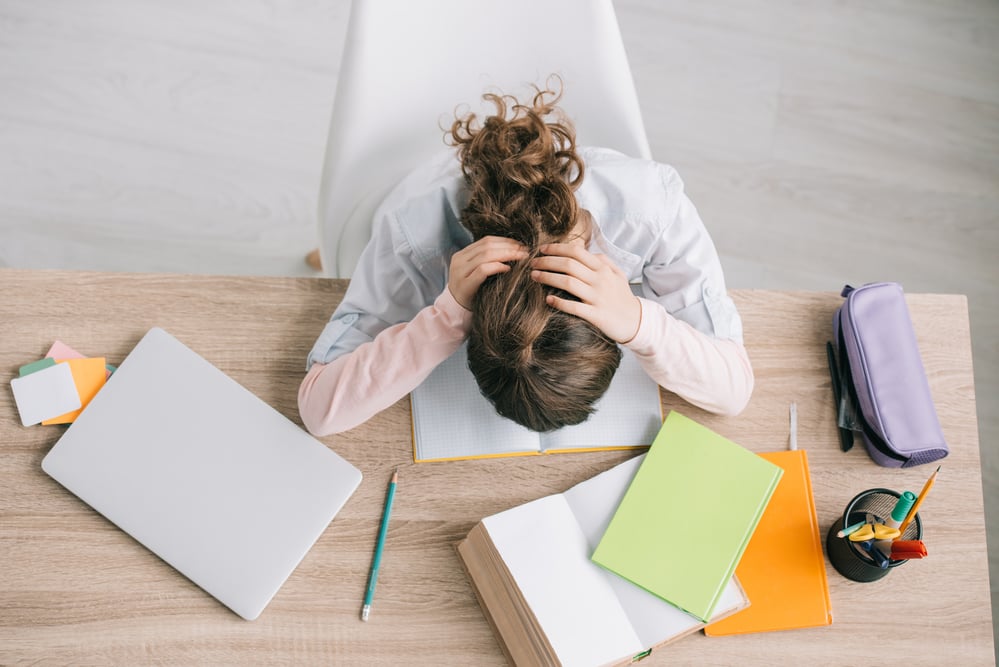
Children who suffer migraines may be having a more difficult time due to online learning. Screen time is often a trigger for migraines. With additional time spent for school increasing screen time to as much as eight hours a day, it’s no wonder the rates of childhood migraines are up.
Before the pandemic and lockdowns, many children and teens spent more time online socializing, playing games, and watching videos. Add in online learning, and the amount of time in front of a monitor abruptly increases. A survey about screen time by Dr. Marc DiSabella at Children’s National Hospital found the following:
- 44% reported using screens more than 6 hours a day.
- 42% have a constant headache that never goes away compared to 18% reporting headaches pre-pandemic.
- 41% reported their headaches worsened since the pandemic began.
- 38% feel more stressed since the pandemic began.
- 42% feel screens are making their headaches worse.
- 58% say they sometimes or very often need to take screen breaks due to worsening headaches.
This post will go into what, exactly, a migraine is, how to identify them in children, and how parents can help. Also, we provide a few relief options to help mitigate the severity of their migraines.
What Is a Migraine?
While migraines cause head pain, they are not merely headaches. A migraine is a complex neurological disorder caused by brain changes, especially on the surface of the brain. During a migraine, the blood vessels dilate. Migraines cause alterations to the blood flow in the brain and create inflammation.
Saying that migraines are neurological disorders sounds a little scary, but it serves to highlight the difference from a common headache.
Migraines tend to have phases, although not all migraineurs (people who suffer from migraines) experience each phase.
The phases, in order, include:
- Prodrome - a pattern of symptoms that may let a migraineur know a migraine is coming, anywhere from a few hours to a couple of days ahead of the attack.
- Aura - a distortion of sight that happens with some sufferers and can herald an imminent attack.
- Headache - the intense, severe head pain experienced during a migraine.
- Post-drome - a constellation of symptoms experienced as the migraine recedes.
One more item to note: many individuals, including children, have depression as a co-morbidity (a condition experienced in tandem with another) of migraines.
Identifying Migraines in Children
Children, especially adolescents going through hormonal changes, find their attacks triggered more frequently.
Around four to ten percent of children experience migraines. For many, the common triggers include:
- The menstrual cycle
- Inconsistent eating patterns
- Dehydration
- Certain foods like cheese, artificial sweeteners, nitrites in processed meat, or MSG (monosodium glutamate)
- Stress
- Inconsistent sleep patterns
- Certain medications such as that for depression or blood pressure
The prototypical symptom is severe, throbbing head pain that can last from four to 72 hours. Adults may experience the pain on one side only. Children more commonly experience pain on the sides of the head that wraps around the forehead above the eyes.
Visual disturbances such as aura may be part of a child's migraine. Also, children more commonly experience nausea, vomiting, and abdominal pain along with head pain. For younger children, extreme sleepiness is often an issue that helps identify migraines.
Migraines in children and teens often have quick onset but may not last as long as those in adults and occur less frequently. Children and teens often experience nausea and vomiting, extreme sleepiness, dizziness or vertigo, and sudden tiredness. Migraine can cause a decline in academic performance if the attack occurs early in the day.
There is a genetic component to migraines. Children in families where migraines are prevalent are more likely to experience it.
Types of Migraines
Migraines are separated by sets of symptoms.
About one-fourth are migraines with aura. An aura can be a visual, sensory, or motor disturbance that presents as a chemical wave across the visual cortex. The child may see sickle or C-shaped objects or zig-zag lines. Others may experience a numb or tingling limb, speech or language problems, or facial weakness.
An aura tends to last between ten and 30 minutes, often preceding the migraine but may accompany it.
A common migraine is a migraine without aura. Common migraines are the most frequently seen and affect up to 90% of sufferers. A migraine can last several hours to several days. The child may become sensitive to light and sound and experience blurred vision, and head pain. Nausea and vomiting may occur along with a stiff neck and shoulders.
There are migraines without head pain, also called silent migraines. The sufferer’s head doesn’t hurt, but they may have other symptoms such as aura, diarrhea or constipation, and sensory issues.
Hemiplegic migraine and retinal migraine are rare. A hemiplegic migraine causes the child to experience weakness on one side of the body along with head pain. Retinal migraines are also called ocular migraines and may be seen as twinkling lights.
Chronic migraine is a designation assigned to those who suffer 15 or more headache days per month.
How Parents Can Help
Since screen time tends to increase the occurrence of migraines, printing out assignments can help. Also, try moving the monitor back or modify the display settings.
Help the child take frequent breaks from staring at the screen. Practice the 20-20-20 rule: every 20 minutes, look at an object at least 20 feet away for 20 seconds.
Place lighting sources behind the child and structure the day to reduce stress. Make sure they drink plenty of water to reduce dehydration. And you can skip the blue glasses. There is not enough evidence they help against migraine attacks.
Watch the child for symptoms and get a physician's assessment if the migraines recur or last a long time. Take severe head pain in younger children seriously - aggressive headache is uncommon at that age. They have a higher chance of developing brain tumors or other developmental abnormalities that can present as headaches.
Migraine Relief
Reducing the severity and frequency of migraines may require a mix of medication and behavioral changes.
Over-the-counter medications like acetaminophen and ibuprofen can reduce pain. In very severe cases, abortive IV therapy is available to stop it in its tracks. Caffeine may be an abortive as well.
Preventive therapy includes drugs like amitriptyline or topiramate taken daily. Relaxation helps reduce the severity and may keep the frequency down.
Have the child sleep in a cool, dark room propped up on a pillow. Keep the room quiet. Use cold packs for pain relief. Enforce a consistent sleep schedule and healthy eating plan. Make sure they exercise and hydrate. A little caffeine may be helpful.
Manage stress and use cognitive behavioral therapy or biofeedback. Other remedies include aromatherapy, physical therapy, and acupuncture. Ginger ale or tea, peppermint tea, crackers, and lemon-lime soda can help alleviate nausea and dehydration.
Conclusion
Being a kid these days is tough. When children and teens suffer migraines, life gets even tougher. Parents, teachers, and healthcare providers can help reduce migraines' frequency and severity using the tips in this post.
If you have any questions, please don’t hesitate to call.



